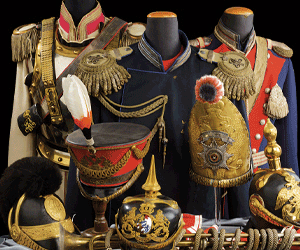German Red Cross Generalführer Shoulder Boards
SKU: 70.GOR.03.02.01.01.002
Estimated market value:

Estimated market value:
Attributes
History
Following the First World War, the German Red Cross (Deutsches Rotes Kreuz, DRK) was threatened in its existence by the Treaty of Versailles, since the organisation was mainly focused on preparing its members for war and military-related medical service. This resulted in the DRK switching focus to social welfare activities during the time of the Weimar Republic.
The stipulations enforced by the Treaty of Versailles were declared null and void following the NSDAP’s consolidation of power in 1933. The new Reich Minister of the Interior, Wilhelm Frick, an NSDAP member, ensured that the DRK would be ready to support all of the Third Reich’s future military affairs and political ideologies. In 1938, the DRK was merged with the Ministry of the Interior’s Social Welfare Organisation, officially becoming an organisation under NSDAP oversight. The DRK also had ties to the SS, mainly due to high-ranking medical professionals serving in both organisations simultaneously.
The design of the Third Reich DRK insignia was initially based upon the uniforms used during the First World War and the Weimar Republic, but substantial uniform changes were implemented in September 1935. Pre-1935 shoulder boards feature rank pips in the shape of a rosette. This was changed to pips in the shape of a four-sided star in 1935.
The shoulder boards were worn on the DRK service tunic and greatcoat, and they were the only rank insignia featured on the DRK uniforms. One shoulder board was worn on each shoulder.
General ranks shoulder boards are unique in their use of interwoven gold-coloured cords on a grey wool underlay. They remained constant in design from 1935 to 1945, the only change being the slightly darker colour of wool used for the underlay after 1938.
Generalhauptführer shoulder boards feature gold-coloured cords on a grey wool underlay, and one silver-coloured pips. Generalführer shoulder boards are similar, but feature no pip.
Field grade Officer shoulder boards are composed of interwoven silver-coloured (aluminum) cords on a grey wool underlay. They remained constant in design from 1935 to 1945, the only change being the slightly darker colour of wool used for the underlay after 1938.
Oberstführer shoulder boards feature silver-coloured cords on a grey wool underlay, and two gold-coloured pips. Oberfeldführer shoulder boards are similar, but feature only one gold-coloured pip, while Feldführer shoulder boards feature no pips.
Company grade Officer shoulder boards are composed of two flat, double-laid silver-coloured (aluminum) cords on a grey wool underlay. They remained constant in design from 1935 to 1945, the only change being the slightly darker colour of wool used for the underlay after 1938.
Hauptführer shoulder boards feature silver-coloured cords on a grey wool underlay, and two gold-coloured pips. Oberwachtführer shoulder boards are similar, but feature only one gold-coloured pip, while Wachtführer shoulder boards feature no pips.
There are two patterns of DRK Enlisted Ranks shoulder boards. The first pattern was in use from 1935 to 1938, and the second pattern from 1938 to 1945.
The rank of Haupthelfer with Zugführer Certificate was added in 1938. The shoulder boards are composed of a flat grey wool base bordered in two rows of aluminum piping that extends along the bottom of each shoulder board, one silver pip, and a 10mm aluminum tress bar at the base..
The first pattern of the Haupthelfer shoulder boards is composed of a flat grey wool base bordered in light-grey wool piping, and three stacked aluminum tress bars, each measuring 10mm in width. The second pattern is also composed of a flat grey wool base, but has the wool piping replaced with two rows of aluminum piping along the boards’ exterior, and one silver pip.
The rank of Oberhelfer with Zugführer Certificate was discontinued after 1938. Thus there is only one pattern of these shoulder boards, and they are composed of a flat grey wool base bordered in light-grey wool piping, and each shoulder board has three stacked aluminum tress bars at the bottom, with the bottom two bars measuring 10mm in width and the upper bar 5mm in width.
The first pattern of the Oberhelfer shoulder boards are composed of a flat grey wool base bordered in light grey wool piping, and at the bottom of each board are two stacked aluminum tress bars measuring 10mm in width. The second pattern is also composed of a flat grey wool base with two rows of aluminum piping along each boards’ exterior.
The first pattern of the Vorhelfer with Gruppenführer Certificate shoulder boards are composed of a flat grey wool base bordered in light grey wool piping. At the bottom of each board are two stacked aluminum tress bars, the bottom bar measuring 10mm in width and the top bar measuring 5mm. The second pattern of the Vorhelfer with Gruppenführer Certificate shoulder boards are also composed of a flat grey wool base bordered in light grey wool piping, with one silver-coloured pip in the centre, and the bottom of each board has a 10mm aluminum tress bar.
The first pattern of the Vorhelfer shoulder boards are composed of a flat grey wool base bordered in grey wool piping with one aluminum tress bar at the bottom of each board, measuring 10mm in width. The second pattern of the Vorhelfer shoulder boards are composed of a flat grey wool base bordered in light grey wool piping with one silver-coloured pip in the centre.
The design of the Helfer/Anwärter shoulder boards remained constant from 1935 to 1945. These shoulder boards are composed of a flat grey wool base bordered in light grey wool piping with no additional tress or pips.


Comments
Sign in to comment and reply.


Scroll Top